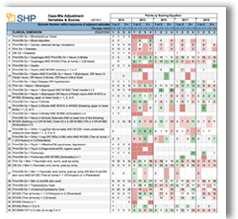July usually starts the month off with fireworks, but this year the proposed rule was issued on July 2nd with its own bang at just under 600 pages. The big news - Home Health Groupings Model (HHGM) is now the Patient-Driven Groupings Model (PDGM). Although there were a few modifications to the co-morbidity adjustment group, increasing the number of HHRGs from 144 to 216 groups, the other changes were not all that significant.
With the Bipartisan Budget Act of 2018 (BiBA), it was clear that CMS had to take action in order to meet the deadline of implementing four critical sections of the law by adding: 1) a 30 day payment unit; 2) a case-mix methodology that excludes therapy visits as a factor; 3) budget neutrality; and 4) behavioral adjustments to be made on a prospective basis. All four were reviewed and commented on in the proposed rule.
At the recent NAHC Financial Managers Conference the president of NAHC, Bill Dombi, noted that when the industry put forth proposals to get the HHGM pulled from the final rule last year, much of what the industry proposed in return, they got. It is unlikely there will be additional pushback to stop PDGM from being implemented at this point.
Below are a few other highlights from the proposed rule related to the Home Health Value Based Purchasing (HHVBP) program, Home Health Quality Reporting Program (HHQRP), new Home Infusion Benefit and the changing HH PPS case-mix weights (CMW).
HHVBP
The changes to this pilot program are significant if your agency is in one of the 9 demonstration states. Starting with performance year 4 (January 2019), the proposal includes eliminating 5 measures, adding two composite measures, reweighting the measure scores to emphasize the claims based measures more, and capping improvement points at nine.
CMS noted that 60 day hospitalizations were not improving and starting next year, close to 25% of the scoring will be with that one measure. Another issue agencies will face is not knowing how the composite scores may impact their Total Performance Scores since no data has been shared at this point. For performance year 4, up to 7% of agency Medicare payments (plus or minus) will be based on these revised HHVBP measure outcomes.
HH QRP
In an effort to reduce the number of reported measures that are either topped out or do not have the significance they originally intended, as of January 2021 HH QRP, CMS plans to remove the following measures from Home Health Compare:
| HH QRP Measure | M-Items |
|---|---|
| Depression Assessment Conducted Measure | M1730 |
| Diabetic Foot Care and Patient/Caregiver Education | M2401 row a |
| Multifactor Fall Risk Assessment Conducted | M1910 |
| Pneumococcal Polysaccharide Vaccine Ever Received | M1051, M1056 |
| Improvement in the Status of Surgical Wounds | M1340, M1342 |
| Emergency Department Use without Hospital Readmission during the First 30 Days of HH | N/A – Claims based |
| Rehospitalization during the First 30 Days of HH | N/A – Claims based |
I was a little surprised to see 30 day readmissions on the chopping block given the importance and financial impacts it has on referring hospitals. CMS commented that the 60-day hospitalization measure already includes the same hospitalizations included in the 30 day readmissions. One of the seven criteria CMS uses to decide if a measure should be removed is whether a more broadly applicable measure is available for the particular topic.
Home Infusion
To meet the requirements of the 21st Century Cures Act, CMS is proposing new benefit category for home infusion therapy services starting in CY 2021 including transitional payments for CY 2019 and CY 2020. In addition, CMS noted proposals for health and safety standards for home infusion therapy and an accreditation and oversight process for qualified infusion therapy suppliers. I expect there will need to be further clarifications in how home health and infusion therapy services begin and end in coordinating care between the two providers.
HH PPS Case-mix
Annually since CY 2015, CMS recalibrates the HHRG case-mix weights (CMW) using the latest available claims and cost data. As part of this process, CMS continues to de-weight the high therapy-based episodes as well as update the scoring methodology for calculating the Clinical and Functional Domains. This will be the last year that this scoring methodology will be used.
CY 2019 proposed CMWs would decrease an average of 1.6% over CY 2018 with all but 18 of the 153 HHRGs reflecting CMW decreases.
There were relatively minor changes to the grouper variables used. The CY 2019 four-equation model resulted in 113 point-giving variables being used in the model (as compared to the 119 variables for the CY 2018 recalibration). A couple of notable exceptions:
- Vision is back! – for the first time since CY 2014, one point will be scored in the 1st equation of the model
- Groups 35 – 41 that refer to ulcers and surgical wounds, all 28 point-giving variables received fewer points with the exception of two.
To help agencies see where the finalized changes were made, SHP has prepared a PPS Case-Mix Scoring and Thresholds Comparison Guide on how the HHRG scoring is affected, including the mapping and scoring of the new clinical and functional domains. The service domains are not changing at this point.

Take this opportunity to review the proposed rule and submit your comments to CMS by August 31st. I will plan two follow-up blogs to dissect the HHVBP and PDGM in greater detail.

